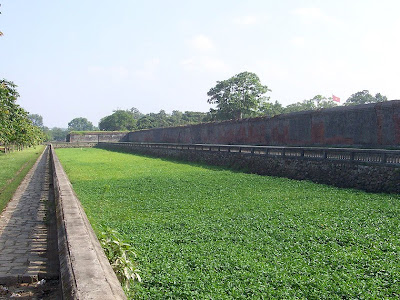We arrived in Hue and were besieged by so many touts, we literally couldn't move out the station doorway, and finally agreed to take a taxi for $1 to the funky area of town, so we could make our minds up, except despite claiming to be doing this, the taxi nevertheless took us to a hotel of his choice and dumped us there, so I had to get Christine to wait while I walked to budget alley, with all the cheap funky hotels, where I promptly found a good air con double for a song at the top of the Lonely Planet list - the Hoang Huong - and retrieved Christine and the luggage from the clutches of a $10 more upmarket establishment.
 The other end of budget alley and the little local restaurant with good meals for 50c each
The other end of budget alley and the little local restaurant with good meals for 50c eachWe dined for a very reasonable price at the Dong Tam restaurant c25,000 dong or about $1.60 US each for a full vegetable plate. The restaurant with its guest house and and the Huang Huong guest house we stayed in formed part of so-called 'budget alley' a quiet cul-de-sac across the Perfume River from the citadel in the guest house quarter.
The guest house arranged everything from an air conditioned double room for $6, through push bikes at $1 a day, motor bike for $4 a day plus gas, and the bus ticket to Hoi An for $2.50. They also gave us breakfast for $1 each and sent us out to the bus cunningly so we got by far the best front seats when it trawled around the guest houses for nearly an hour picking up passengers.
The guest house arranged everything from an air conditioned double room for $6, through push bikes at $1 a day, motor bike for $4 a day plus gas, and the bus ticket to Hoi An for $2.50. They also gave us breakfast for $1 each and sent us out to the bus cunningly so we got by far the best front seats when it trawled around the guest houses for nearly an hour picking up passengers.


We spent the rest of the day cycling together to the old citadel - a complete walled city and to the Imperial or
Forbidden City of the Vietnamese emperors, bombed to hell by General Westmoreland and only recently beginning to be restored under the agency of UNICEF.









Video of Music and Arts Performance Finale

Most of the Forbidden City is severely destroyed and is a grassy wasteland, but several of the residences of the Emperor's family and some audience halls around the periphery have been restored.











 The Perfume River with boats at sunset
The Perfume River with boats at sunset
We returned to make a second visit to the citadel area on a motor bike to see the large areas outside the Forbidden City where there are large moats which function both for cultivation and as public park spaces.



We also visited the canals surrounding the citadel with their own boat life





Roughly along the Perfume River from Huế lie myriad other monuments, including the tombs of several emperors, including Minh Mạng, Khải Định, and Tự Đức. Also notable is the Thiên Mụ Pagoda, the largest pagoda in Huế and the official symbol of the city.
So we also took the motor bike out to the south west of the city to visit some of the temples and the Royal Tombs of the emperors and nobility.




Vietnam is literally littered with ornate graves and this form of effective ancestor worship comes to a climax with the royal tombs surrounding Hue, some of which are fully restored but others of which are lying semi-derelict in the wilderness and paddy fields.


Rather than visit the fully restored tomb sites which were expensive and bursting with toursit buses, we decided to take a ride out of town on the back roads and go past a few of the derelict sites.


There is little more here than the peripheral stone work and a ramshackle central shrine containing a great stone commemorating the works of the perpetrator.






We then took off on a side road and ended up on a track through the fields. We had to cross over a very spindly bamboo bridge over a small river and found ourselves on a tiny isolated track overlooking deserted royal tombs in the wilderness.

We then came on the back end of a royal tomb just in the process of being restored.



 The graveyard on the way back to town
The graveyard on the way back to townIn the evening I took the motor bike and rode out the east side of Hue to the beach on the coast. Here are some sights on the way out and back.






 Antique shops outside Budget Alley
Antique shops outside Budget AlleyNext day we took the bus south to Hoi An a famous touristic fishing town south of Da Nang.




Te road south used to cross a very high pass but now much of the road through the hilly country is in a tunnel.








































No comments:
Post a Comment